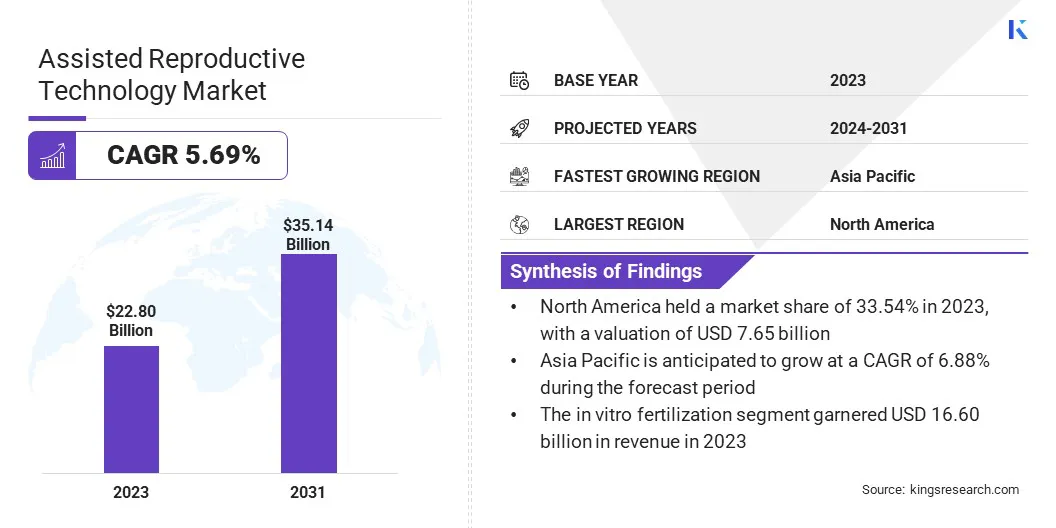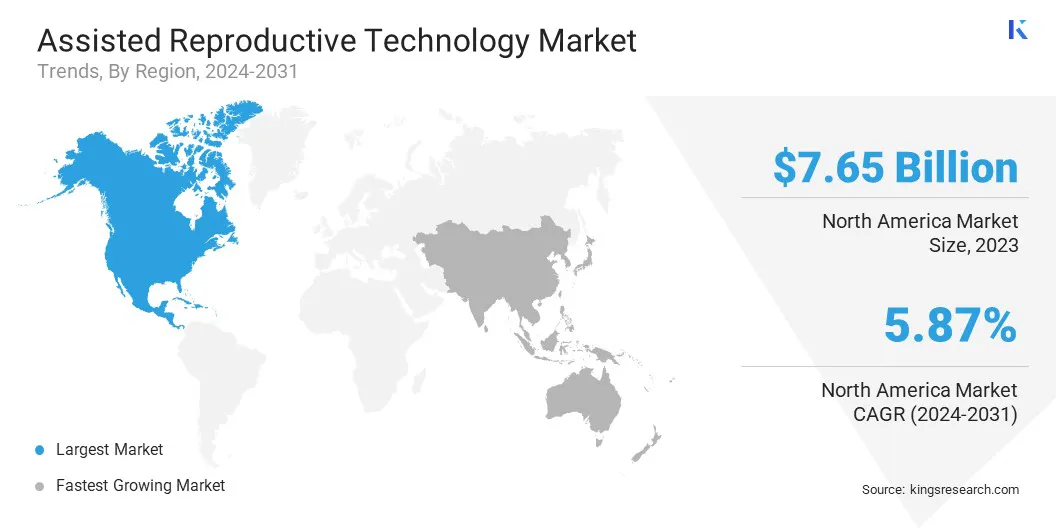Assisted Reproductive Technology Market Size
The global Assisted Reproductive Technology Market size was valued at USD 22.80 billion in 2023 and is projected to grow from USD 23.85 billion in 2024 to USD 35.14 billion by 2031, exhibiting a CAGR of 5.69% during the forecast period. The market is poised to witness substantial growth, mainly due to rising healthcare investments and ongoing advancements in reproductive technologies.
Increasing adoption of genomic testing and personalized medicine, along with supportive regulatory frameworks, is enhancing ART outcomes. Additionally, growing awareness and expanding insurance coverage are broadening access to ART services, thereby propelling market expansion.
In the scope of work, the report includes solutions offered by companies such as Bloom Fertility Centre, CooperSurgical Inc, Ferring, Hamilton Thorne, FUJIFILM Irvine Scientific, Laboratoire CCD, Microm Ltd, Nidacon International AB, Vitrolife, Esco Medical, and others.
The declining birth rates observed in various global regions and the rapid rise in the geriatric population are anticipated to aid the growth of the market.
- For instance, Eurostat's April 2022 update shows that the crude birth rate in the European Union has steadily declined to 9.1 live births per 1,000 people. This trend, coupled with an aging population, is expected to contribute to the growing demand for ART technologies.
As couples and individuals increasingly seek reproductive solutions, the assisted reproductive technology market is set to experience substantial growth over the forecast period. This anticipated expansion reflects the rising need for advanced reproductive technologies to address declining fertility rates and aging demographics.
Assisted reproductive technology (ART) refers to a range of medical procedures used to help individuals or couples achieve pregnancy when facing fertility issues. ART includes techniques such as in vitro fertilization (IVF), intrauterine insemination (IUI), gamete or embryo cryopreservation, and the use of donor eggs or sperm.
These technologies are designed to support conception by addressing various factors that may affect fertility, including hormonal imbalances, physical blockages, and genetic conditions. ART procedures often involve the manipulation of eggs, sperm, or embryos outside the body, with the goal of facilitating successful implantation and achieving pregnancy.

Analyst’s Review
Advancements in IVF technology, increased awareness, strategic government initiatives to regulate surrogacy, and expanded insurance coverage for IVF are poised to stimulate the growth of the ART market.
- For instance, in June 2022, the Indian state of Odisha established a state-appropriate authority and formed the State Assisted Reproductive Technology and Surrogacy Board to regulate IVF clinics and prohibit commercial surrogacy. The Assisted Reproductive Technology (ART) Act provides a pivotal framework for addressing the legal, ethical, and social challenges faced by infertile couples. Under this Act, IVF and ART clinics must obtain registration from a five-member authority led by the Special Secretary (Public Health) of the Health and Family Welfare Department.
Key players may leverage advancements in IVF technology, regulatory support, and expanded insurance coverage to augment market growth by investing in cutting-edge treatments, complying with new regulations, and capitalizing on increased patient access to ART services.
Assisted Reproductive Technology Market Growth Factors
The rising prevalence of factors such as late marriages, stressful lifestyles, obesity, high consumption of junk food, smoking, alcoholism, and drug addiction is leading to the widespread adoption of assisted reproductive technology (ART).
- According to data from the National Library of Medicine published in December 2022, 11% of women globally who have previously given birth are unable to conceive again, and 2% of women aged 20 to 44 are unable to have any live births. Infertility rates are particularly higher in regions such as Eastern Europe, North Africa, and the Middle East.
The growing incidence of infertility is boosting the demand for ART techniques. This increasing demand is propelling market growth.
A major challenge hampering the development of the assisted reproductive technology market is the high cost associated with these treatments, which is expected to limit accessibility for many patients. The expense of procedures such as IVF and associated diagnostic tests hinders market growth and varies due to differences in insurance coverage and regional regulations.
To address this challenge, key players are focusing on reducing costs by investing heavily in cost-efficient technologies and offering patient financing options. They are further concentrating on expanding insurance coverage and improving procedural efficiency. By enhancing affordability and accessibility, they are aiming to make ART more available to a wider audience and foster market growth.
Assisted Reproductive Technology Market Trends
The increasing prevalence of single-parent households, coupled with the growing awareness regarding same-sex marriages and advancements in assisted reproductive technologies, is influencing the growth of the ART market.
- For instance, the Human Rights Campaign (HRC) Foundation's 2022 update indicates that the number of countries where same-sex marriage is legal has risen to 32. Furthermore, parliamentary or judicial proceedings are in progress in several other nations, suggesting that this number is expected to continue increasing.
In addition, as same-sex marriages become increasingly common, the demand for ART techniques is expected to rise significantly. This trend is boosting market growth, as more individuals and couples seek these technologies to start their families, thereby expanding the global reach and impact of ART services.
The growing use of genomic testing and personalized medicine within the assisted reproductive technology (ART) market is emerging as a major trend. Genetic screening techniques, such as preimplantation genetic testing (PGT), are gaining prevalence.
PGT allows for the thorough examination of embryos prior to implantation, thereby enabling the selection of those with the highest potential for successful implantation and optimal development. By identifying genetic abnormalities early, these techniques significantly improve ART outcomes and minimize the risk of genetic disorders in offspring.
The adoption of genomic testing is revolutionizing reproductive medicine, providing couples with more informed choices and enhancing the overall success rates of ART procedures. This trend underscores the shift toward more precise and tailored reproductive healthcare, which contributes to the ongoing growth of the ART market.
Segmentation Analysis
The global market is segmented based on technique, end user, and geography.
By Technique
Based on technique, the market is categorized into in vitro fertilization, artificial insemination, and others. The in vitro fertilization segment led the assisted reproductive technology market in 2023, reaching a valuation of USD 16.60 billion, fueled by continual technological advancements and rising demand for fertility treatments.
Innovations such as improved embryo culture systems, preimplantation genetic testing (PGT), and enhanced cryopreservation techniques are increasing IVF success rates and enabling more personalized treatment approaches.
- According to the American Society for Reproductive Medicine, the number of babies born through IVF rose from 89,208 in 2021 to 91,771 in 2022, with IVF accounting for 2.5% of all births in the U.S.
This increase highlights a steady rise in demand for fertility services, reflecting an ongoing trend toward seeking advanced reproductive solutions to address fertility challenges. Supportive regulations and broader insurance coverage are making IVF more accessible, contributing to significant market growth.
By End User
Based on end user, the market is categorized into fertility clinics, hospitals, research laboratories, and cryobanks. The fertility clinics segment captured the largest market share of 70.71% in 2023. Rising infertility rates globally are increasing the demand for ART services, leading more individuals to seek solutions from specialized clinics.
Technological advancements, including innovations in IVF, ICSI, and egg freezing, are enhancing treatment effectiveness and success rates. Additionally, growing societal awareness and acceptance of ART are contributing to higher patient engagement and increased rates of treatment adoption. Enhanced success rates and the proliferation of specialized, technologically advanced clinics bolster segmental expansion.
Assisted Reproductive Technology Market Regional Analysis
Based on region, the global market is classified into North America, Europe, Asia-Pacific, MEA, and Latin America.

North America assisted reproductive technology market share stood around 33.54% in 2023 in the global market, with a valuation of USD 7.65 billion. This notable expansion is primarily fostered by rising infertility rates and proactive measures undertaken by public organizations. The U.S. benefits from a robust healthcare system and a significant number of fertility clinics.
- For instance, as of March 2023, Centers for Disease Control and Prevention (CDC) reports approximately 500 clinics in the United States.
- Additionally, technological innovations and the introduction of new products, such as FUJIFILM Irvine Scientific’s Heavy Oil for Embryo Culture, which was launched in June 2022, are expected to foster regional market expansion.
Asia Pacific is anticipated to grow at a robust CAGR of 6.88% over the forecast period, largely attributed to rising infertility rates and supportive government policies. Countries such as China and India are seeing increased demand for ART due to rapid urbanization and lifestyle changes.
Government initiatives, such as subsidies for ART treatments in China, are further boosting domestic market expansion. Technological advancements, including innovative embryo culture media and genetic screening tools, are improving treatment outcomes. Additionally, the proliferation of private fertility clinics and increased investments in new centers and international partnerships are enhancing accessibility and aiding market growth.
Competitive Landscape
The global assisted reproductive technology market report will provide valuable insight with an emphasis on the fragmented nature of the industry. Prominent players are focusing on several key business strategies such as partnerships, mergers and acquisitions, product innovations, and joint ventures to expand their product portfolio and increase their market shares across different regions.
Companies are implementing impactful strategic initiatives, such as expanding services, investing in research and development (R&D), establishing new service delivery centers, and optimizing their service delivery processes, which are likely to create new opportunities for market growth.
List of Key Companies in Assisted Reproductive Technology Market
- Bloom Fertility Centre
- CooperSurgical Inc
- Ferring
- Hamilton Thorne
- FUJIFILM Irvine Scientific
- Laboratoire CCD
- Microm Ltd
- Nidacon International AB
- Vitrolife
- Esco Medical
Key Industry Development
- June 2022 (Product Offering): Inception Fertility broadened its services by introducing HavenCryo, a long-term solution for the storage and cryopreservation of reproductive tissue. This new offering enhances the experience for both fertility providers and patients by incorporating cutting-edge technology specifically designed for assisted reproductive technologies (ART).
The global assisted reproductive technology market is segmented as:
By Technique
- In Vitro Fertilization
- Artificial Insemination
- Others
By End User
- Fertility Clinics
- Hospitals
- Research Laboratories
- Cryobanks
By Region
- North America
- Europe
- France
- U.K.
- Spain
- Germany
- Italy
- Russia
- Rest of Europe
- Asia-Pacific
- China
- Japan
- India
- South Korea
- Rest of Asia-Pacific
- Middle East & Africa
- GCC
- North Africa
- South Africa
- Rest of Middle East & Africa
- Latin America
- Brazil
- Argentina
- Rest of Latin America


